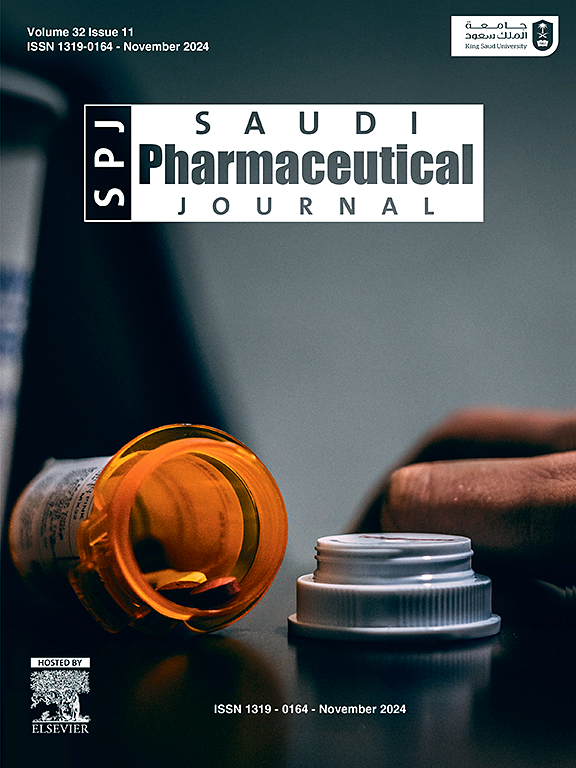Identification and validation of lung adenocarcinoma (LUAD)-associated targets for monascin from the extracts of Monascus purpureus-fermented rice: Compound preparation, high-throughput genome sequencing and bioinformatics analysis
IF 3.4
3区 医学
Q2 PHARMACOLOGY & PHARMACY
引用次数: 0
Abstract
Despite the remarkable bioactivities exhibited by monascin against several tumors, its therapeutic targets remain unexplored. In this study, our objective is to identify therapeutic targets based on the antitumor activity of monascin against lung adenocarcinoma (LUAD) A549 cells. The compound monascin was derived from extracts of Monascus purpureus-fermented rice. Its chemical structure was determined using spectroscopic methods, while the physicochemical properties of monascin were investigated through thermal behavior analysis. Herein, antitumor studies indicated that monascin significantly inhibited the viability of A549 cells, with an IC50 value of 2.05 μM; RNA-sequencing revealed 12 up-regulated and 29 down-regulated genes as differentially expressed genes (DEGs) for A549 cells in response to monascin; RT-qPCR validation supported the plausibility of the RNA-sequencing results. Moreover, utilizing data from the Cancer Genome Atlas (TCGA) database, univariate and multivariate Cox regression analyses provided evidence supporting GPR37 and FAM83A as potential candidate genes for predicting disease progression in LUAD patients. Additionally, the LASSO Cox regression and nomogram analyses confirmed that FAM83A and GPR37 genes had the potential to predict overall survival for LUAD patients. Finally, molecular docking studies suggested that monascin could interact with both GPR37 and FAM83A proteins through the hydrogen bonding and hydrophobic interactions; Western blotting assays indicated that monascin inhibited the expression levels of both GPR37 and FAM83A proteins. Overall, the clinical prognosis of GPR37 and FAM83A highlights the rationale for targeting these specific genes with monascin. Additionally, there findings provide compelling evidence for the polypharmacological properties of monascin against LUAD.
紫红曲霉发酵大米提取物中红曲霉素肺腺癌相关靶点的鉴定与验证:化合物制备、高通量基因组测序和生物信息学分析
尽管红曲霉素对几种肿瘤具有显著的生物活性,但其治疗靶点仍未被探索。在这项研究中,我们的目的是基于monascin对肺腺癌(LUAD) A549细胞的抗肿瘤活性来确定治疗靶点。化合物红曲霉素是从红曲发酵大米中提取的。利用光谱学方法确定了其化学结构,通过热行为分析研究了monascin的理化性质。其中,抗肿瘤研究表明,monascin显著抑制A549细胞的活力,IC50值为2.05 μM;rna测序结果显示,A549细胞在monascin作用下有12个上调基因和29个下调基因作为差异表达基因(DEGs);RT-qPCR验证支持rna测序结果的合理性。此外,利用癌症基因组图谱(TCGA)数据库的数据,单因素和多因素Cox回归分析提供了支持GPR37和FAM83A作为预测LUAD患者疾病进展的潜在候选基因的证据。此外,LASSO Cox回归和nomogram分析证实FAM83A和GPR37基因具有预测LUAD患者总生存的潜力。最后,分子对接研究表明,monascin可以通过氢键和疏水相互作用与GPR37和FAM83A蛋白相互作用;Western blotting检测显示,monascin抑制GPR37和FAM83A蛋白的表达水平。总之,GPR37和FAM83A的临床预后突出了monascin靶向这些特异性基因的合理性。此外,这些发现为monascin抗LUAD的多药理学特性提供了令人信服的证据。
本文章由计算机程序翻译,如有差异,请以英文原文为准。
求助全文
约1分钟内获得全文
求助全文
来源期刊

Saudi Pharmaceutical Journal
PHARMACOLOGY & PHARMACY-
CiteScore
6.10
自引率
2.40%
发文量
194
审稿时长
67 days
期刊介绍:
The Saudi Pharmaceutical Journal (SPJ) is the official journal of the Saudi Pharmaceutical Society (SPS) publishing high quality clinically oriented submissions which encompass the various disciplines of pharmaceutical sciences and related subjects. SPJ publishes 8 issues per year by the Saudi Pharmaceutical Society, with the cooperation of the College of Pharmacy, King Saud University.
 求助内容:
求助内容: 应助结果提醒方式:
应助结果提醒方式:


